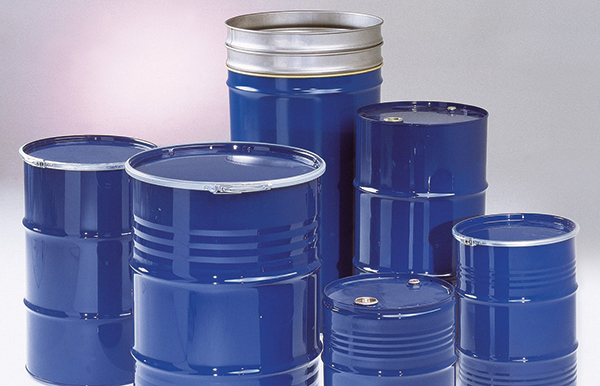Packaging of chemical products
From plastics to fertilizers, from fibers to phytofarmaceuticals, from domestic detergents to inks... the chemical sector is a highly diversified manufacturing sector. The following analysis, in such a complex context, is limited to examining varnishes, accessory products for paints and varnish, inks, lubricants and greases.

In 2015, the Italian chemical industry continued to recover in production (+1.5% in volume), overcoming the recession of recent years with stabilized employment levels and a substantial abatement of recourse to involuntary unemployment benefits.
As mentioned above, this report is limited to the following product categories: varnishes, accessory products for paints and varnish, inks, lubricants and greases. These five categories were selected on the basis of the packaging used. Altogether, the five product sectors saw a total production in 2015 of 2,589 t/000, with 2% growth. However, relative to the period before the long recession, this represents a shrinkage of 10%.
During the course of 2016, these sectors are expected to see a progressive strengthening of this growth, driven both by domestic demand and by exports.
Materials and packaging types
The choice of packaging materials in the chemical products sector is driven mainly by the chemical/physical characteristics of the product to be packaged. However, the packaging product is not only determined by the physical properties of the product. Another important factor is resistance to impact during transport and stackability during storage. The changes determined by marketing are less dynamic compared to those of other sectors, and the variations in shares in the packaging mix are driven by the economic performance of the various segments that make up the chemical sector. The same applies to the choice of panel.
The sector is predominated by large format containers (with capacities exceeding 10 kg, 50-200 kg drums - mostly 200 kg - and tanks with capacity exceeding 200 kg).
This is determined mainly by logistical and economic advantages carried by the use of these containers.
Of course there are also containers of smaller capacities, which, for example, enjoy widespread use for paints.
Breakdown of the five areas under analysis
Paints and varnish. After three years of recession, this category ended 2015 with 1.8% growth (in terms of quantity), thanks mainly to the excellent performance of exports, but domestic demand has also begun to show signs of improvement.
Forecasts are oriented towards a progressively strengthening recovery, driven both by export growth and by increasing domestic demand.
The most widespread packaging type is the steel container, with a 50% share, subdivided into cans of various formats, 200 kg non-tinplate steel drums and spray cans. Plastic containers are the alternative to steel solutions and include formats up to 30 kg capacity as well as 200 kg drums. They have reached a share of 40% and are gaining ground. In particular, plastic containers are used for water-based paints.
The remaining 10% has to do with “tanks”, with strong growth potential in accessory products for paints and varnish. The latter saw 1.5% growth in 2015 thanks to exports, but the growth prospects for 2016 are oriented towards a trend of progressive growth that is also driven by recovering domestic demand.
Packaging in this sector is limited to steel packaging, particularly tinplate for formats up to 50 liters and non-coated steel for formats over 50 liters (mainly 200 liters).

Inks. The printing inks sector saw approximately 1% growth in 2015 and held up better than other segments even in the face of the crisis’ negative repercussions.
This is due partly to the progressive gains of package printing, particularly the strong performance of polylaminates for converting, which continued to grow even while the industry generally saw slowdowns.
Another important driver of the continued strong consumption of inks is the expanded printable surface of cardboard boxes and labels.
Packaging for inks largely consists in tinplate up to 30 liters (47% share).
Plastic containers for capacities up to 30 liters, showing a positive growth trend, have reached a share of 13.5%.
The segment also uses 200 liter steel and plastic drums (9% and 5% shares, respectively).
The use of steel tanks has a 25.5% share (and growing).
Lubricants and greases. This sector has seen considerable stagnation in recent years, following a progressive drop in the quantities used by the automotive sector (cars, trucks, etc.), tempered by modest growth in industrial uses (lubrication of production systems and machinery generally).
As far as regards lubricant oils and greases for cars, however, it should be noted that the fall in consumption is mainly determined by the characteristics of new motors compared to old ones.
Another major transformation, also in the field of automotive lubricants, has to do with the progressive transition from 1-30 liter containers (both tinplate and plastic) to 200 liter steel or plastic drums and, in many cases, tanks. This phenomenon is easily explained: whereas previously “fill-ups” took place at service stations that used 1.5 liter capacity containers, in recent years the rise of discount maintenance services at specialized shops has driven operators to choose larger capacity containers.
The packaging of lubricants is seeing a progressive decline in tinplate containers to the benefit of plastic solutions.
Greases are packaged exclusively in steel containers.
Plinio Iascone
Istituto Italiano Imballaggio




















